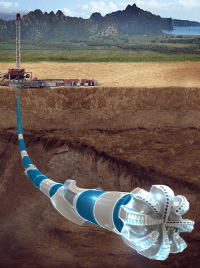Directional drilling simulation
Have you ever wondered how oil wellbores that go from the ground surface to oil reservoirs are drilled, or how these processes can be computationally simulated? Researchers from McGill University, Concordia University and NOV Wellbore Technologies are helping us understand it all.
 The process
The process
Oil wellbore drilling can be an extremely complex procedure, especially when the reservoir location is not vertically below the surface location and directional drilling is required to reach the target. The wellbore path must be carefully planned out, taking into consideration the surface and target locations, geological formations and reservoir characteristics. A drilling rig is set up at the selected drilling location, on land or off shore (see Figure 1). A drill bit, in combination with various downhole tools, is used to create the wellbore as the drill string is lowered from the rig (see Figure 2). Powered by a downhole motor, the bit spins and drills through the earth and rock underneath until the oil reservoir is reached. In order to steer the drill bit and produce curved wellbores, there is a slight bend in the motor which must be oriented from the surface to achieve the predetermined well path, which is the key characteristic of directional drilling.
A high-fidelity simulation tool
 A group of researchers from McGill's Centre for Intelligent Machines (Montreal, Quebec), Concordia University (Montreal, Quebec) and NOV Wellbore Technologies (Edmonton, Alberta) have developed a software tool for the dynamic simulation of directional drilling. The project is being funded by an NSERC Collaborative Research and Development Grant and by NOV Wellbore Technologies.
A group of researchers from McGill's Centre for Intelligent Machines (Montreal, Quebec), Concordia University (Montreal, Quebec) and NOV Wellbore Technologies (Edmonton, Alberta) have developed a software tool for the dynamic simulation of directional drilling. The project is being funded by an NSERC Collaborative Research and Development Grant and by NOV Wellbore Technologies.
The tool is based on a high-fidelity model of the drilling assembly and on state-of-the-art computational mechanics algorithms, namely the finite element method and multibody dynamics (see Figure 3). The results, which are soon to be published in a prestigious scientific journal, show that the simulation tool accurately predicts the wellbore trajectory, the stresses within the drilling assembly and the contact forces.
 Prospects
Prospects
According to the authors of the work, S. Arbatani, A. Callejo, J. Kovecses, M. Kalantari, N. Marchand and J. Dargahi, this physics-based simulation tool will greatly improve the accuracy with which motor directional performance can be predicted. It will accurately calculate downhole loading conditions and component stresses to better understand tool limitations and determine proper operating specifications. Moreover, by using simulation results as part of the design process, it will enable improved optimization of component geometry to optimize performance and enhance tool life.
All figures © NOV Wellbore Technologies, McGill University, Concordia University